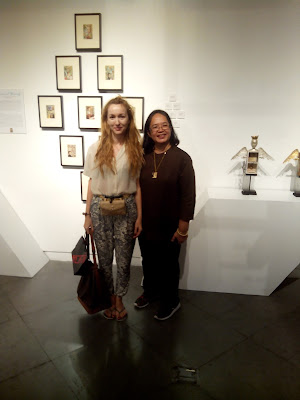 |
| Sta. Rosa de Lima |
I wrote about the Advocates for Heritage Preservation tour of Malolos last month. I've been looking forward to this heritage tour Of Binan and Sta. Rosa, Laguna for weeks. Finally, Saturday, the 27th came along. I was up early so I won't miss the carpool ably arranged by Johnson Bernardo. While waiting for the van, I met a few other AHP members I haven't met before, Fritzie Ramos, Waff Recalde and Tan Ocampo.
 |
| Sta. Rosa de Lima Church |
And then the van arrived on the dot. We loaded up and sped off towards Sta. Rosa and Binan. Sta' Rosa is approximately 38 km south of Manila. Named after, St. Rose of Lima, the town was elevated to city status covering an area of 54.13km2. Discovered in 1573 by Spanish explorer Juan de Salcedo, the area was annexed to Tabuco, now known as Cabuyao, Laguna. Then it was annexed to Binan and by 1688, it was separated from Binan to be named Barrio Bucol (Bucal?) Then by 15 January 1792, the city of Sta. Rosa was founded.
 |
| Zavalla house |
Formerly an agricultural area, it's rich soil and abundant water was a hot target for Tulisanes (bandits) during harvest time for them to replenish provisions and stock up on supplies for long, lean months of fighting against the guardia civil. Yes, some revolutionaries were branded as merely bandits who were discontented with their lot in life. That's where the short sighted vision of the Spaniards failed them. They didn't realize the discontent would fester into all out revolution.
 |
| Tiongco house |
Anyway, the Jesuits usurped the lands from the local landowners. They gathered the residents into communities and hamlets and the prominent families were given prominent positions in their barrio. Upon expulsion of the Jesuits, the Dominicans took over the management of these friar estates and remained under the control of the friars reaching as far out to the north in San Pedro de Tunasan and as far south west to Silang and Amadeo, Cavite.
 |
| Gonzales house |
General Pio del Pilar fought alongside Filipino revolutionaries against the Americans in this area. Its rich history is further enhanced with the city's participation against the Japanese forces. As the American forces were pushing their way to Manila from Tagaytay, the Japanese continued to wreak havoc in areas they retreated to. By 5 February, 1945 the Japanese had abandoned Sta. Rosa.
 |
| Almeda Heritage house |
Binan, on the other hand was the richest city in Laguna prior to American occupation. It is approximately 34km southwest of Manila. It was used as a base for Spanish forces to combat the Tulisanes. Eventually, it became a hub for business. Then the area became more popular as an industrial hub when then Governor of MetroManila, Imelda Romualdez Marcos wanted to decongest Manila of factories. Some of them moved to Sta. Rosa and Binan.
 |
| Former munisipyo, then hospital |
This visit was made special as the AHP members were allowed access to ancestral homes in Sta. Rosa. We visited three homes The Zavalla, Tiongson and Gonzales homes before we moved on to Binan, Laguna to experience the Almeda and another Gonzales home then visited the Cuarteles.of We got to visit and see for ourselves, the former detention cell occupied successively by three controversial detainees: Nur Misuari, Erap Estrada and Janette Lim-Napoles. That was pretty cool! before the sun went down, the AHP group disbanded and went our merry way.
 |
| Cuarteles |
Looking forward to our next heritage tour in Sta. Ana, Manila next month. That's 25, July, 2015! If you're looking for a brilliant way to spend a lazy weekend... you're invited to join the Advocates for Heritage Preservation. Look up the Facebook page headed by Tito Encarnacion. It isn't just a fun way to learn history and culture, it's a cool way to meet new people and embrace your identity as a Filipino.
 |
| piitan ni Janette Lim-Napoles, Erap at Misuari |





































